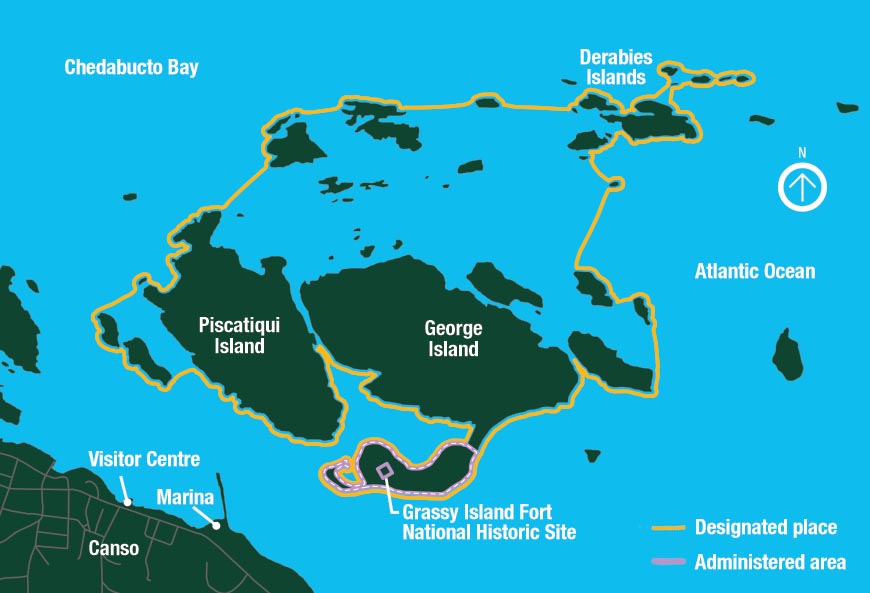Canso Islands and Grassy Island Fort National Historic Sites of Canada Management Statement, 2021
Canso Islands National Historic Site

Table of contents
Title: Canso Islands and Grassy Island Fort National Historic Sites of Canada Management Statement, 2021
Organization: Parks Canada Agency
Foreword

Minister of Environment and Climate Change and Minister responsible for Parks Canada
Parks Canada administers one of the finest and most extensive systems of protected natural and cultural heritage areas in the world
These national historic sites, national parks and national marine conservation areas are a source of shared pride for all Canadians.
The Government of Canada is committed to preserving natural and cultural heritage, expanding the system of protected places and contributing to the recovery of species-at-risk. At the same time, we must continue to offer new and innovative visitor and outreach programs and activities so that more Canadians can experience these iconic destinations and learn about our environment, history and culture.
In addition, Parks Canada is committed to a system of national heritage places that recognizes and honours the historic and contemporary contributions of Indigenous peoples, their histories and cultures, as well as the special relationships Indigenous peoples have with ancestral lands and waters.
This new management statement for Canso Islands and Grassy Island Fort national historic sites of Canada supports this vision.
Management statements are developed through extensive consultation and input from various people and organizations, including Indigenous peoples, local and regional residents, visitors and the dedicated team at Parks Canada.
National parks, national historic sites and national marine conservation areas are a priority for the Government of Canada. I would like to thank everyone who contributed to this statement for their commitment and spirit of co-operation.
As the Minister responsible for Parks Canada, I applaud this collaborative effort and I am pleased to approve the Canso Islands and Grassy Island Fort National Historic Sites of Canada Management Statement.
Recommendations
Recommended by:
Ron Hallman
President & Chief Executive Officer
Parks Canada
Andrew Campbell
Senior Vice-President
Operations Directorate
Blair Pardy
Field Unit Superintendent
Cape Breton Field Unit
Introduction
Parks Canada manages one of the finest and most extensive systems of protected natural and historic areas in the world. The Agency’s mandate is to protect and present these places for the benefit and enjoyment of current and future generations. This management statement outlines Parks Canada’s management approach and objectives for Canso Islands and Grassy Island Fort national historic sites of Canada.
Canso Islands and Grassy Island Fort national historic sites are commemorated because Canso Islands constituted an important fishing base for the French in the 16th and 17th centuries and for the British in the first half of the 18th century. The Historic Sites and Monuments Board of Canada recommended Canso as a site of national historic significance in 1925. In 1962, the Board recommended recognition of the prominent archaeological site in the Canso area, the fort at Grassy Island, as being of national historic significance. In 2001, the Board recommended that the site be known as Canso Islands National Historic Site and include the islands that constituted Canso in its historic sense, and that Grassy Island National Historic Site be renamed Grassy Island Fort National Historic Site.
The Mi’kmaq people had a historical presence on these islands for fishing and transportation. Nine pre-contact Indigenous artifacts are part of the archaeological collection for the site. The Mi’kmaq also played an important role, along with the French, in overtaking the fortifications during King George’s War in 1744. Although Parks Canada has compiled some information related to the importance of the sites to the Mi’kmaq, current understanding is limited. Gaining further understanding of the significance of these sites to the Mi’kmaq needs to be explored.
Canso Islands and Grassy Island Fort national historic sites are located adjacent to the community of Canso, within Guysborough County. Tourism is an important emerging sector regionally, and the site plays an important role in the tourism offer for Canso.
Management approach
Parks Canada will continue to manage Canso Islands and Grassy Island Fort national historic sites to grow relationships and pursue partnerships that offer opportunities for discovery of the sites and building an appreciation and understanding for their stories.
Parks Canada will also ensure the commemorative integrity of these sites, working with the Mi’kmaq of Nova Scotia to review and update the commemorative integrity statements, which document the sites’ national historic significance.
Management objectives
Building relationships with the Mi’kmaq of Nova Scotia
Parks Canada respects Aboriginal rights, including those identified within peace and friendship treaties, when building mutually beneficial relationships with Aboriginal communities, which is a priority for Parks Canada. In managing Canso Islands and Grassy Island Fort national historic sites, Parks Canada works with Mi’kmaq communities directly and through the Parks Canada-Unama’ki Advisory Committee to ensure management decisions are informed by both western and Mi’kmaw knowledge, as well as reflect the values and cultural heritage of the Mi’kmaq people. Areas of interest moving forward include: reviewing and updating the commemorative integrity statements to reflect Mi’kmaq history and connections to the site; inclusive cultural resource management, including greater understanding of the history of the sites through collaborations in archaeology; cross-promotional visitor experience activities and potential employment or contracting opportunities.
Building relationships with local/regional partners
By working together with key stakeholders, including the Canso Historical Society, Canso Area Development Association and the Municipality of the District of Guysborough, Parks Canada maximizes opportunities to present the stories of the sites and provide enhanced services.
Resource conservation
Parks Canada protects cultural resources at heritage places administered by the Agency in accordance with its Cultural Resource Management Policy and the Standards and Guidelines for the Conservation of Historic Places in Canada.
The statement of commemorative integrity and reasons for designation of Canso Islands and Grassy Island Fort National Historic Site will be reviewed and updated collaboratively with the Mi’kmaq of Nova Scotia.
As well, recognizing that the sites have significance for the Mi’kmaq, Parks Canada commits to collaboratively working with the Mi’kmaq of Nova Scotia to better understand and protect the values and cultural resources of Mi’kmaw significance at these sites, including from climate change impacts such as coastal erosion and sea-level rise.
Conservation includes basic monitoring of the state of cultural resources, and documentation of interventions at the site. At Canso Islands and Grassy Island Fort national historic sites, the focus is on ensuring that the known cultural resources are not impaired or threatened, that investments are made where they are most impactful for the benefit of Canadians, and that messages about the historic significance of Canso Islands and Grassy Island Fort national historic sites are conveyed.
Public understanding and appreciation
Parks Canada provides information about the significance of Canso Islands and Grassy Island Fort national historic sites on its website, through social media and on the Canadian Register of Historic Places. Parks Canada also delivers related outreach activities and has promotional information available at regional visitor information centres.
Site maintenance
Parks Canada maintains the property it administers so as to respect the site’s heritage values, present a positive image to the public, and reflect the Parks Canada brand.
Summary of strategic environmental assessment
In accordance with The Cabinet Directive on the Environmental Assessment of Policy, Plan and Program Proposals (2010), a strategic environmental assessment is conducted on all management statements tabled in Parliament. The strategic environmental assessment for Canso Islands and Grassy Island Fort national historic sites assessed the potential effects on natural and cultural resources and visitor experience. The strategic environmental assessment concluded that the proposed management statement for Canso Islands and Grassy Island Fort national historic sites would have positive effects on cultural resources and visitor experience. Potential environmental effects on vegetation, species at risk, migratory birds and water quality were identified, but the effects can be mitigated through project-level impact assessments when necessary. The statement supports the Federal Sustainable Development Strategy goal of Connecting Canadians with Nature. There are no important negative environmental effects anticipated from management statement implementation.
Contact us
For more information about the management statement or about Canso Islands and Grassy Island Fort National Historic Sites of Canada, please contact:
Canso Islands and Grassy Island Fort National Historic Sites of Canada
P.O. Box 159
Baddeck, Nova Scotia, B0E 1B0
Canada
Email: pc.information.pc@canada.ca
Canso Islands and Grassy Island Fort National Historic Sites of Canada
Fax number: 902-295-3496
Publication information
© Her Majesty the Queen in Right of Canada, represented by the President & Chief Executive Officer of Parks Canada, 2021.
Front cover image credit: Parks Canada
Cette publication est aussi disponible en français.
- Paper: R64-582/2021E
- 978-0-660-39297-4
- PDF: R64-582/2021E-PDF
- 978-0-660-39296-7
Note to readers
The health and safety of visitors, employees and all Canadians are of the utmost importance. Parks Canada is following the advice and guidance of public health experts to limit the spread of COVID-19 while allowing Canadians to experience Canada’s natural and cultural heritage.
Parks Canada acknowledges that the COVID-19 pandemic may have unforeseeable impacts on the Canso Islands and Grassy Island Fort National Historic Sites of Canada Management Statement.
- Date modified :
